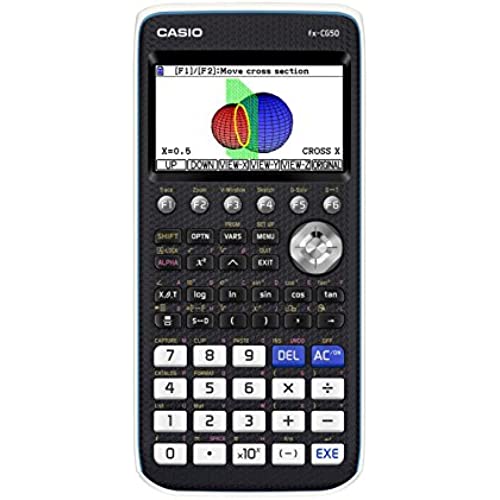
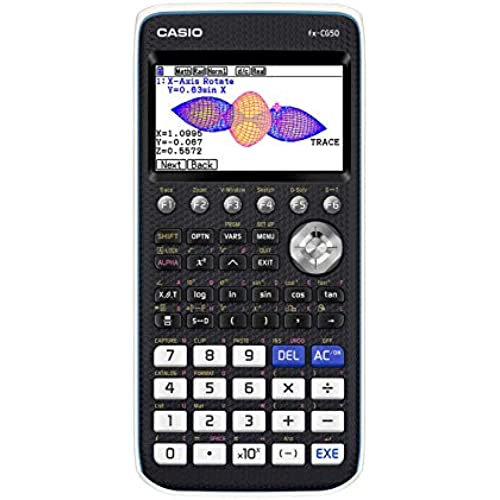
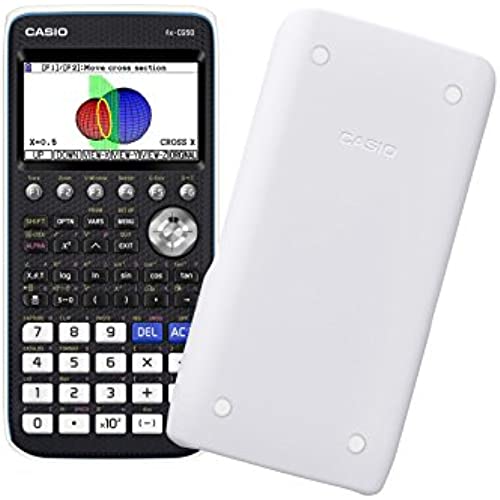
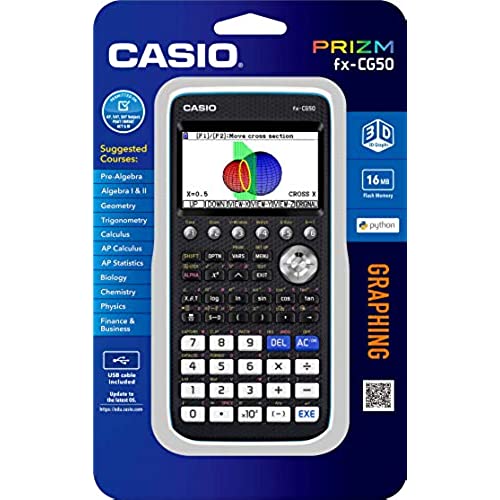
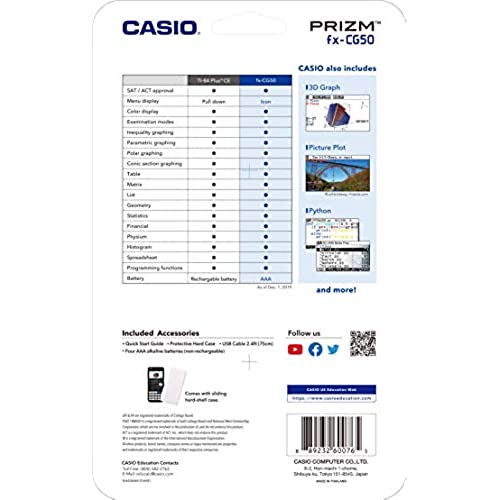
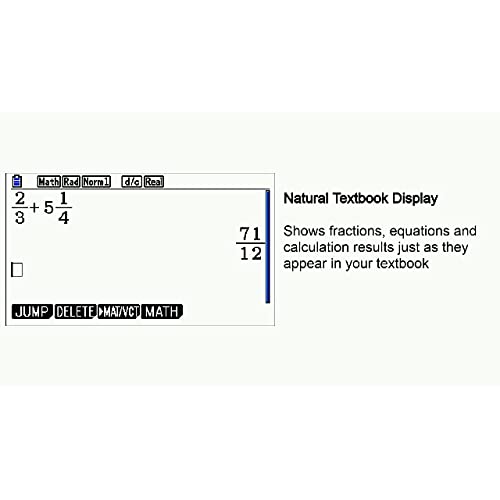






CASIO PRIZM FX-CG50 Color Graphing Calculator,Black & White,7.21Wx10.32Lx2.05H
-

Jennifer
> 3 dayI just got this for my statistic class. I love it. It is quite a bit bigger than I thought but I am thinking because it is more like a computer than a regular calculator this is to be expected. And I am loving this thing so much!!! If you are dealing with statistic and need a all in one device to help. get this item it is amazing! I do love Casio products.
-

Brie
> 3 daySo, if you never delve into programming much, chances are you wont have too much issue with Casio Prizm FX-CG50. Its a really good calculator, especially if you are not a high-tech person who will easily miss programming features or lack of memory. If you are the average person, it wont stand out to you that the memory is lacking below even the TI-84 and will in fact run out of things get too big for it. However, unlike the TI-84, it does not obsessively use decimals when it could be giving you the exact value that this calculator will give you. This is enough for many people to ditch the TI-84 decimal-obsessed calculator that has barely evolved for a decade. The TI-84 is very old, outdated, and causes work that is completely unnecessary in modern studies. Scientific calculators are not CAS and yet give exact values for radians and roots, so really there is no excuse for it in the aged TI-84 calculator. This calculator, however, does have both scientific and graphing abilities that give exact value where it can. So as far as graphing calculator feature, I give it a 4 out of 5. TI-84 is a 3 out of 5. The Casio Prizm FC-CG50 has a more sturdy body than the TI line of calculators. It is better made as far as body and material. When you hold it in your hands, it has a nice strong sturdy grip on it. A grip you cannot find in any of the TI lines of calculators, which feels too light and flimsy. It also has larger, easier to press keys that would be better for stronger hands. It is also better for people that need larger text. A lot. Not as strong as the older models. As far as Casio, I dont think there was too much better it could do. It is above baseline. I give it a 5 out of 5 for quality and sturdiness. TI-84 and nSpire only are very basic 3 with quality and the other company for sure held back. Now in the area of programming, which makes or breaks modern graphing calculators. For this calculator, since it offers both native programs and micro-python, we will look at both areas of programming, separately: Native Programs: When it comes to native (non-Python) programming on the Casio Prizm FX-CG50, there is so much to be desired. For native calculator programming, it is beaten out horribly by the TI-84. Its not the language thats the huge problem, but rather the way the whole thing is set up. Its just not user-friendly and very, very little has been put into making programming this calculator easy. Unlike Texas Instruments Ti-84, you cannot run programs while the device is plugged into the PC to test it. Instead, expect to go through a drawn-out process of exporting the program to text, to a folder within the calculator, then plugging it into the PC as attached storage, editing with a completely unguided text notepad, putting the file back on the computer, unplugging it again because it wont work while plugged in -- then allowing the calculator to convert the text file back to a program, of which it will often fail. This is because all of those commands look just like regular text but arent. They are some other kind of bytecode. So the converter often gets very confused trying to parse the text file back to binary -- it cant always tell an intended command from the text. It is both confusing for the user and the converter -- in and out of the calculator. They could at least color the commands in the internal debugger, but you literally cannot visually tell text from the command other than the way the cursor hops across it. That it was done this way was just a very bad idea as far as the programming world. So, as far as the native programming language of the calculator, you pretty much are best off programming right in the calculator, which is extremely slow in that you are using the calculators limited keyboard. To Casio: It would greatly benefit your market if you offered a FREE interface for debugging, testing programs on the PC/Mac without a clumsy emulator interface as TI does. The reason why the TI programming community is so large is that programming with the TI is so much more flexible and easier. People want to help your brand and end this monopoly on the other side, by making code for it, but lets be real. You dont make it easy for us. The verdict: I give the PRIZM FX-CG50 only a 2/5 overall. With TI-84, native programming, its a 4 out of 5 for overall native programming. It cant be a 5, since the Ti-nSpire is already that and will run circles around both of these calculators. Casios way of doing things is so frustrating, many people just jump straight to hacking the calculator with assembly or the calculators internal micro-python which is way better. The language itself isnt bad at all and seems on par with Ti-84s calculator, its just you barely want to deal with it. Also -- oh and a big one -- it lacks string support. If you dont care about this, then moving forward in this review you wont find much more drawbacks. Truly, this is the main thing working against it. Now. As far as python support, this calculator is pretty strong in comparison. If it wasnt for its lack of memory over the Ti-84, it is almost best out (except not over nSpire, which even the non-CAS can version can be beaten out only by a CAS calculator because of its memory and power of it). The python on the FX-CG50 calculator is less stripped-down than the one on the TI-84, so you will find you can use more native python libraries on it than you can the TI-84. For example, TI-84 lacks regular expression support, while the other two have limited Regular Expression support. For people who need the strength of this calculator but also want stronger programming ability, its the Python on this calculator that will actually save it some returns. Python implementation is as follows: Ti-84 is 3 out of 5 as far as python library implementation, but a 5/5 with the internal python programming interface which is pretty nice. FX-CG50 is 4 out of 5 mainly due to lack of memory, with its library implementation, but the python internal programming interface is a basic 3. Its okay. Most people doing anything in-depth will likely program on a computer and import it. Neither one of them stand close to TI-nSpires python implementation. But how could it not be better when it has far more memory than these two? Now, dont think the Ti-Nspire is the obvious option though. Again, the US American version of the Ti-Nspire, like TI-84, also excessively uses decimals over the exact answer (that most NON-CAS scientific AND non-as graphics calculators do not do) which means more work for the student and running out of time on tests trying to convert answers back. That doesnt seem worth the money to me. It is the modern standard now, to give you radians and roots as exact values. You will get that with FX-CG50. But for some odd reason, TI-84 has not learned that. It must have something to do with the monopoly and making the calculator just difficult enough to keep teachers comfortable because CAS calculating has absolutely nothing to do with non-symbolic exact values, which radians nor roots are not. So, due to CX-CG50 Python support, which saves it, I prefer, slightly, this calculator over the TI-84. Thats because youre likely to get through tests faster with it, even on test mode, without having to use all those convert options that you shouldnt have to do with a calculator of this price tag. Plus, the calculators python has regular expression support, which is super huge. Its like, what is python without re? TI-84 has more functions, more resolution, yes. But its really, really hard for some people to get past all those conversions required because the company wont take a clue. And the python. Without RE support, thats nearly unredeemable. As a note, I own TI-84 CE Python, Casio Prizm FX-CG50, TI-nspire CX II CAS, and TI-nSpire CX II-T (non-cas). Summary: - So, in sum, as a calculator, Casio Prizm FX-CG50 is more modern than the TI-84. It will give you roots and radians without converting them to decimals in most cases. Outdated TI-84 fails to do this. This ability defaults on European non-CAS calculators. Yes, even on TIs UK/Euroepan models, for some odd reason. Just not here. - Casio Prizm FX-CG50 has better python library implementation, but less memory than the TI-84. - TI-84 has a better internal python debugger, though most people may do coding on a PC and import. - TI-84 is much more flexible and has much better native programming support than the Casio Prizm FX-CG50 -- rather in or off the calculator. - Ti-Nspire has much better memory, more functions, and greater programming and python programming support than both calculators do. However, the US version of it is greatly crippled like the TI-84, in that it does not give exact values on radians and roots like the FX-CG50 does. Ti-84 is knocked on outdated calculation results and graphing user-friendliness, and this calculator gets a knock on native programming flexibility. For TI-84, you can download programs for just about any issue, even conversions -- but if your school will put it in test mode, that is useless. On the other hand, most issues that make programming on the FX-CG50 problematic, are resolved through its python-support. The conclusion in washing all features and losses together is that the Casio Prizm FX-CG50 is worth its money, while the Ti-84 CE (Python/ or not) isnt. It can no longer be justified by the price tag.
-

Sabrina Phinitpapha
> 3 dayboosts popularity, i got tons of kids numbers using my #1 calculator
-

Alvera Harris
> 3 dayEasier to use than Texas Instruments 64
-

Luke
> 3 dayI found it much easier to use than the TI93 Plus I had, and the additional programs proved extremely helpful. Im sure Im only scratching the surface of its capabilities, but that also means I have plenty of room to grow with it. Some reviews listed the AAA batteries as a liability, but I think they are useful in their own way. Scenario: Heading to a test, you realize your battery is low. -With new rechargeable calculators, what are your options? Have your charger and cable ready, and then find a spot to stop and wait for it to charge. If you have time. -With a battery powered calculator, given the same scenario, you can either carry spares for such an occasion or swing by a convenience store and grab a pack real quick. This very situation popped up for me, and I was glad to have the latter.
-

Stephen J. Fundock
> 3 dayI recently ordered this calculator(fx-CG50) from Casio. Here is why you should NOT buy this calculator. I wanted to get a manual on hor to operate. No such thing. You will get a Quick start Guide: This guide is just for the very basic about this calculator. If you want to go into the advanced parts,you will be sadly out - of - luck. This, is why I say - Dont Buy unless you are a psycic who can understand everything. I doubt you will see this on their website. I hope Amazon will let this print. It is the Major drawback of this computer . Thank you. Steve Fundock.
-

Martha Milena Rueda
> 3 dayThis product turns on and works Jokes aside, its a good calculator It does what its supposed to do
-

Martinez
> 3 dayOverall a complete and full featured graphing calculator. It will and can get you through every standard math course in college that you will take. From your basic algebra course to a differential equation course. It will also get you through stats classes. So feature wise this calculator is the equal of the TI-84 Plus CE (if not better in some areas due to its menu driven GUI vs TIs list based GUI system). Hardware wise the CG-FX 50 is superior in processor speed, screen space, font size, and graph rendering speed vs the TI-84 Plus CE. Cost wise it blows the TI-84 Plus CE out of the water. So in both performance, features and price the Casio CG-FX 50 is the way to go. P.S. The CG-FX 10 Prism is a great predecessor from which this calculator was derived from but it too is over priced on Amazon. The CG-FX 50 is the successor of that calculator and so it makes sense to pick the CG-FX 50 over the CG-FX -10. Never mind the updated button styling from CGFX-10 which was non-standard vs the standard button styling of the CG-FX 50 that mirrors most other calculators. If this does not make sense to you or actually matter to you a all then dont worry about it. Just realize that the CG-FX 50 is the superior choice here as well.
-

Alejandra rivera basto
> 3 dayLlegó en perfectas condiciones y funciona muy bien
-

Nicki
> 3 dayHaving to use AAA batteries is worth what this calculator is capable of. Upsides: It graphs up to 20 functions in a fraction of the time of the ti 84. You can choose decimal or exact outputs for your calculations. It has statistics, spreadsheet, and even Python programming capabilities. It has an app specifically for calculating finances. It has a list of 6 different probability simulators. It has 50 or so different conversion capabilities. It has a massive list of commonly used constants in maths, physics, etc. It even has a built in periodic table with quick descriptions of where some of the elements can be found. It also has a test mode that can be activated, making it school test legal. Downsides: It’s possible to accidentally delete apps if you are unsure of what you’re doing. They can be easily recovered on Casio’s website however. It is not as user friendly as the TI series of calculators. It’s quite a bit more complicated than them, but is offset by the fact that it is capable of a lot more. Casio does have a hefty user guide online for it, which is nice if you really want to figure it all out. I am extremely pleased with this calculator. It was absolutely worth the sale price, and definitely worth its normal price. Since it can run Python programs, I’m going to try and get it to run Doom.
